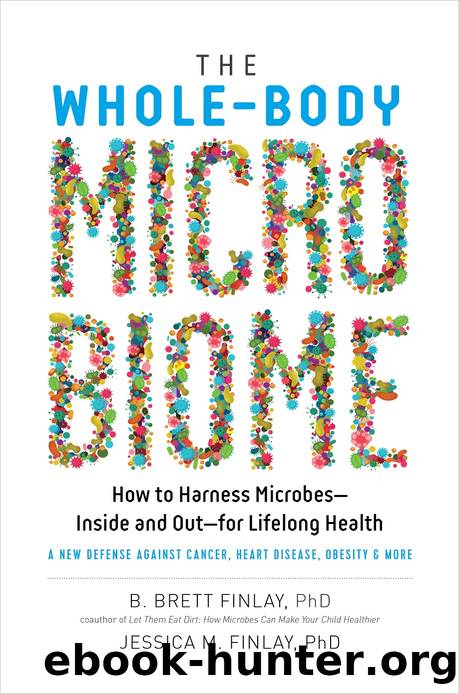The Whole-Body Microbiome by B. Brett Finlay

Author:B. Brett Finlay
Language: eng
Format: epub
Publisher: The Experiment
Published: 2018-11-30T20:55:24+00:00
Menopausal Microbes
Given the significant changes in the vaginal environment during menopause, it is not surprising to see more direct changes in menopausal and post-menopausal vaginal microbiomes—though unlike premenopausal vaginal microbiomes where there are monthly shifts in the community, the post-menopausal vaginal microbiome seems remarkably stable. During menopause (the point when periods stop), the microbiome is still dominated by lactobacilli (although to a lesser degree, in total numbers), including L. crispatus, and L. iners, as well as Gardnerella vaginalis, and Prevotella; and a lower abundance of Candida, Mobiluncus and Staphylococcus, Bifidobacterium, and Gemella. In the years following menopause (referred to as “post-menopause”), there is an overall decrease in lactobacilli and replacement with other microbes. The lactobacilli can degrade glycogen into organic acids, especially lactic acid, which keeps the vagina acidic. After menopause there is less lactobacilli and less lactic acid production. This then increases the vaginal pH, which some believe may help to explain an increase in risk for UTIs and gynecological infections among older women.
Estrogen keeps the vaginal surface healthy by triggering the deposition of glycogen (a sugar) on the vaginal mucosal surface. Like plants in need of regular fertilizer, these vaginal microbes need glycogens for sustenance. Lack of estrogen causes the genitourinary syndrome of menopause (GSM)—also termed vulvovaginal atrophy, vaginal atrophy, and atrophic vaginitis. This leads to a thinning of the vaginal wall, which means less glycogen deposition and fewer of the beneficial resident microbes. Symptoms of GSM include dryness, itching, burning, urgency to pass urine and/or urinary leakage, lack of lubrication and bleeding during intercourse, vaginal discharge, susceptibility to sexually transmitted infections, and inflammation of the vagina. Up to half of all post-menopausal Western women experience these symptoms, with vaginal dryness being the biggest complaint.
In a Swedish study that compared twenty fertile (pre-menopausal) women to twenty post-menopausal women, fertile women had far more diversity in the subspecies of lactobacilli. Another study confirmed the correlation between glycogen levels and Lactobacillus species: Post-menopausal women have decreased glycogen and lactobacilli. There are strong correlations between vaginal health and lactobacilli—and inverse correlations with Gardnerella and Atopobium, two biofilm-forming species also seen with BV. Generally, but not always, GSM is associated with lower levels of lactobacilli. One study of post-menopausal women divided them into groups based on vaginal dryness. In the group that had no to mild vaginal dryness, the women were rich in Lactobacillus species and had low bacterial diversity, both positive markers of vaginal health. In the group that had more severe vaginal dryness, the women were colonized with fewer lactobacilli, and had more bacterial diversity, including Prevotella, Porphyromonas, Peptoniphilus, and Bacillus. Individuals with more severe signs of GSM tend to have higher vaginal microbiota diversity that is not dominated by lactobacilli. In a sense, vaginal health is promoted through a dysbiotic population—contrary to nearly every other finding in this book. Somehow, we need to restore high lactobacilli levels while decreasing the bacterial diversity for postmenopausal vaginal health.
If lack of estrogen causes these issues, wouldn’t adding it back do the trick? Estrogen levels and healthy microbes do seem to go hand in hand.
Download
This site does not store any files on its server. We only index and link to content provided by other sites. Please contact the content providers to delete copyright contents if any and email us, we'll remove relevant links or contents immediately.
| Cell Biology | Developmental Biology |
| Entomology | Marine Biology |
| Microbiology | Molecular Biology |
| Biostatistics |
Sapiens: A Brief History of Humankind by Yuval Noah Harari(13052)
The Tidewater Tales by John Barth(12029)
Do No Harm Stories of Life, Death and Brain Surgery by Henry Marsh(6336)
Mastermind: How to Think Like Sherlock Holmes by Maria Konnikova(6235)
The Thirst by Nesbo Jo(5785)
Why We Sleep: Unlocking the Power of Sleep and Dreams by Matthew Walker(5641)
Sapiens by Yuval Noah Harari(4537)
Life 3.0: Being Human in the Age of Artificial Intelligence by Tegmark Max(4507)
The Longevity Diet by Valter Longo(4445)
The Rules Do Not Apply by Ariel Levy(3905)
The Immortal Life of Henrietta Lacks by Rebecca Skloot(3826)
The Body: A Guide for Occupants by Bill Bryson(3800)
Why We Sleep by Matthew Walker(3771)
Animal Frequency by Melissa Alvarez(3755)
Yoga Anatomy by Kaminoff Leslie(3701)
Barron's AP Biology by Goldberg M.S. Deborah T(3631)
The Hacking of the American Mind by Robert H. Lustig(3579)
All Creatures Great and Small by James Herriot(3515)
Yoga Anatomy by Leslie Kaminoff & Amy Matthews(3395)
